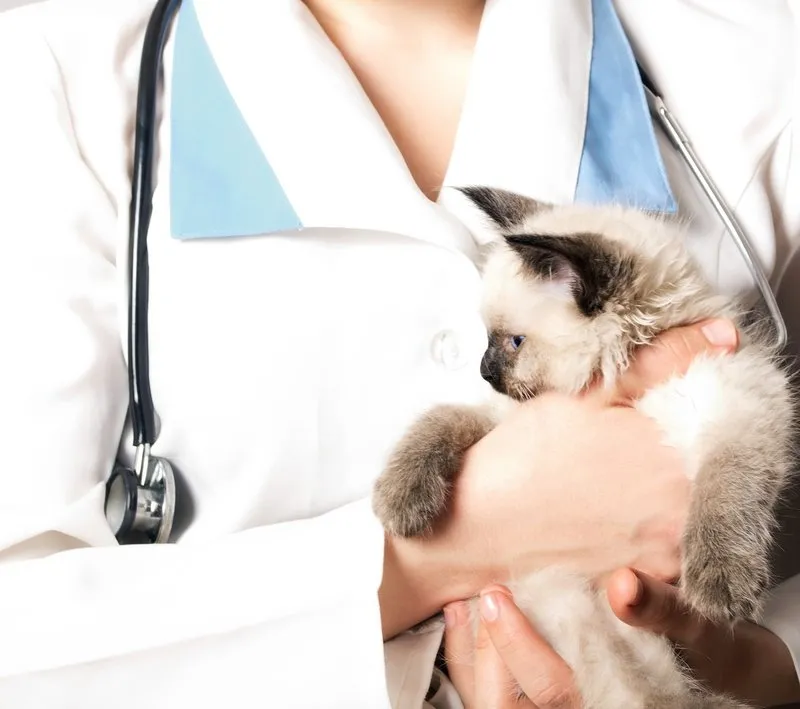Is your feline friend sporting formal wear? If so, put a kitty pawprint on your calendar for September 9th: it’s Tuxie Appreciation Day! A Roanoke, VA vet discusses these fashion-forward felines below.
Tuxie Love
As it turns out, September 9th isn’t the only official tuxie holiday. January 29th is Tuxedo Appreciation Day. Then, in November, the 28th is National Tuxedo Cat Day! OF course, Fluffy certainly won’t mind if you celebrate her a few extra times a year. Tuxies are very, very good at wrapping us around their paws.
What Breed Of Cat Is A Tuxedo?
Tuxedo coloring isn’t confined to any specific breed or breeds. Quite a few kitties are allowed to don that formal attire if they choose.
What Are Tuxedo Cats Like?
If we were to ask Fluffy this question, she’d no doubt describe herself as regal. However, we have to be honest and report that tuxies are just as silly, quirky, and hilarious as any other kitty. They just look fancier when they’re making mischief. Tuxies have broken records for loud purrs, and they may open their eyes before other kittens, but there’s still some research to be done before we can call those tidbits definitive facts.
Are Tuxedo Cats Rare?
Tuxedo coloring isn’t rare: in fact, if you look up available kitties from any local shelter, you’ll likely find at least one or two. Of course, all of our feline buddies are one-of-a-kind, so in that aspect, Fluffy is completely unique! As tuxedo cats age, they may develop certain health issues, such as dementia. To learn more about the signs of cognitive decline in older felines, check out our article on Signs Of Dementia In Kitties.
Fun Fact About Tuxedo Cats
For many years, it was thought that Fluffy got her coat pattern because, well, she basically ran out of ink. Kittens first develop pigment cells along their spine, so the original assumption was that tuxies didn’t have as many black pigment cells as they needed, leaving them their distinctive white socks and shirt. However, more current research points to a specific gene. If you notice any changes in your tuxedo cat’s health or behavior, our Veterinary Diagnostics services can help identify any underlying issues and develop an appropriate treatment plan.
Not-So-Fun Fact About Tuxedo Cats
Tuxies actually need all of those awareness days. These pretty kitties often have a hard time getting adopted! If you’re considering getting a new feline pal, a tuxie may be a great choice!
Famous Tuxies
Quite a few famous black-and-white furballs have won our hearts. The most famous ones are animated kitties. There’s Sylvester from Looney Tunes, Tom from Tom and Jerry, and Felix, the cartoon strip star. Of course, you can’t forget Dr. Seuss’ Cat In The Hat!
Our Advice on Tuxie Appreciation Day in 2024
What is Tuxie Appreciation Day, and when is it celebrated?
Tuxie Appreciation Day is a special day dedicated to celebrating tuxedo cats, those charming felines adorned with a distinctive black and white coat that resembles formal attire. This day is marked on September 9th, offering cat lovers an opportunity to show extra love and appreciation for tuxedo cats. It’s one of several days throughout the year highlighting these stylish kitties, recognizing their unique appearance and the joy they bring to their human companions. Celebrating Tuxie Appreciation Day encourages acknowledgment of their special place in our homes and hearts.
Can tuxedo coloring be found in specific cat breeds, or is it more widespread?
Tuxedo coloring is not confined to any specific cat breed but is a widespread pattern across many breeds and mixed-breed cats. This distinctive black-and-white coat pattern can appear in various cat populations regardless of pedigree, making it a familiar yet beloved feature among cats. Tuxedo refers to the unique distribution of black and white fur that resembles formal attire, and it occurs due to the cat’s genetics, not its breed. Therefore, a wide range of cats, from domestic shorthairs to certain purebreds, can sport this elegant “outfit.”
Is the tuxedo coloration in cats considered rare?
Tuxedo coloration in cats is not considered rare. This distinctive black-and-white pattern is typical and can be found in many cats, regardless of their breed or mix. The pattern, characterized by a predominantly black coat with white markings typically on the chest, paws, and sometimes the face, results from a specific genetic expression. Tuxedo cats are prevalent in various populations worldwide, making them a familiar and beloved choice among cat enthusiasts and adopters alike.
What does recent research suggest about the tuxedo coat pattern in cats?
Recent research suggests that the tuxedo coat pattern in cats is linked to a specific gene that controls the distribution of black and white fur. This gene influences pigment cell migration during embryonic development, producing a characteristic formal wear appearance. The tuxedo pattern is not a result of a shortage of pigment cells, as once thought, but rather how these cells are distributed under genetic influence. This genetic basis highlights the complexity of coat coloration in cats and the role of genetics in their physical traits.
Why do tuxedo cats often struggle with adoption rates?
Tuxedo cats often struggle with adoption rates due to common misconceptions and the abundance of cats with this coat pattern in shelters. Despite their striking appearance and charming personalities, tuxedo cats can be overlooked for cats with more unique or less common colorations. Additionally, the number of cats needing homes means tuxedo cats face stiff competition for potential adopters’ attention. Raising awareness about the plight of tuxedo cats, especially on days dedicated to their appreciation, can help improve their chances of finding loving homes.
Do you have questions about cat care? Contact us, your Roanoke, VA pet hospital, today!



